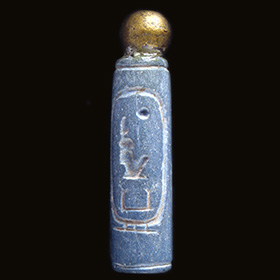New Kingdom Rulers
- Neolithic Period: 4500-3000 BCE
- Early Dynastic: 3000-2650 BCE
- Old Kingdom: 2650-2150 BCE
- 1st Intermediate Period: 2150-2040 BCE
- Middle Kingdom: 2040-1640 BCE
- 2nd Intermediate Period: 1640-1550 BCE
- New Kingdom: 1550-1070 BCE
- - Architects: Amenhotep, Son of Hapu
- - Architects: Senenmut
- - Rulers: Amenhotep III
- - Rulers: Amenhotep IV
- - Rulers: Hatshepsut
- - Rulers: Ramses II
- - Rulers: Ramses III
- - Rulers: Thutmose III
- - Rulers: Tutankhamun
- - Monuments: Abu-Simbel
- - Monuments: Abydos - The Temple of Seti
- - Monuments: Akhetaton (Tell el-Amarna)
- - Monuments: Amenhotep III’s Mortuary Complex
- - Monuments: Deir-el-Bahri
- - Monuments: Luxor Temple
- - Artifacts: Link to Collection Search
- 3rd Intermediate Period: 1070-712 BCE
- Saite and Late Periods: 712-332 BCE
- Greco-Roman Period: 332 BCE-642 CE
- Coptic Period: 395-642 CE
- Islamic Period and Modern Times: 642 CE-Today
- Neolithic Period: 4500-3000 BCE
- Early Dynastic: 3000-2650 BCE
- Old Kingdom: 2650-2150 BCE
- 1st Intermediate Period: 2150-2040 BCE
- Middle Kingdom: 2040-1640 BCE
- 2nd Intermediate Period: 1640-1550 BCE
- New Kingdom: 1550-1070 BCE
- - Architects: Amenhotep, Son of Hapu
- - Architects: Senenmut
- - Rulers: Amenhotep III
- - Rulers: Amenhotep IV
- - Rulers: Hatshepsut
- - Rulers: Ramses II
- - Rulers: Ramses III
- - Rulers: Thutmose III
- - Rulers: Tutankhamun
- - Monuments: Abu-Simbel
- - Monuments: Abydos - The Temple of Seti
- - Monuments: Akhetaton (Tell el-Amarna)
- - Monuments: Amenhotep III’s Mortuary Complex
- - Monuments: Deir-el-Bahri
- - Monuments: Luxor Temple
- - Artifacts: Link to Collection Search
- 3rd Intermediate Period: 1070-712 BCE
- Saite and Late Periods: 712-332 BCE
- Greco-Roman Period: 332 BCE-642 CE
- Coptic Period: 395-642 CE
- Islamic Period and Modern Times: 642 CE-Today
Hatshepsut
1507 BCE – 1458 BCE
Hatshepsut was the first female pharaoh to rule Egypt with the full power of the position. She ruled for twenty years. Hatshepsut was pharaoh during the Eighteenth Dynasty. After the death of her husband, Thutmose II, Hatshepsut didn’t claim the title as pharaoh of Egypt right away. Instead, she was regent on behalf of her stepson (born to a secondary wife), Thutmose III, who was a young child at the time. After less than seven years, however, Hatshepsut took the unprecedented step of assuming the title and full powers of a pharaoh herself, becoming co-ruler of Egypt with Thutmose III. She claimed to be the child of Amun and transformed herself into a king by wearing the symbols of kingship. She emphasized her right to rule through her bloodline.
Hatshepsut also took a new name, Ma’at kare, sometimes translated as Truth (ma’at) is the Soul (ka) of the Sun God (Re). The key word here is ma’at—the ancient Egyptian expression for order and justice as established by the deities. Maintaining and perpetuating ma’at to ensure the prosperity and stability of the country required a legitimate pharaoh who could speak—as only pharaohs could—directly with the deities. By calling herself Ma’at kare, Hatshepsut was likely reassuring her people that they had a legitimate ruler on the throne.
One important way pharaohs affirmed ma’at was by creating monuments. Hatshepsut’s building projects were among the most ambitious of any pharaoh. She began with the erection of two 100-foot-tall obelisks at the Great Temple Complex at Karnak. Reliefs commemorating the event show the obelisks, each weighing about 450 tons, being towed along the Nile by 27 ships manned by 850 oarsmen.
Her greatest achievement was the enormous memorial temple at Deir el-Bahri, considered one of the architectural wonders of ancient Egypt. The construction was supervised by Senenmut, her loyal advisor. There has been much speculation across the centuries about a possible romantic relationship between Senenmut and Queen Hatshepsut, largely focusing on his unusual rise to prominence and access to the queen and her daughter.
Hatshepsut renewed trade with western Asia to the east, the far-off land of Punt to the south, and the Aegean Islands to the north. The resulting economic prosperity was reflected in the art of the time, which is characterized by remarkable innovations in sculpture and decorative arts.

Image: RC 1114 Hatshepsut Bead at the Rosicrucian Egyptian Museum.
http://www.ancient.eu/hatshepsut/
http://www.guardians.net/hawass/hatshepsut/search_for_hatshepsut.htm
http://www.history.com/topics/ancient-history/hatshepsut
http://www.metmuseum.org/exhibitions/listings/2006/hatshepsut
http://www.pbs.org/wgbh/nova/ancient/expedition-punt.html
http://www.smithsonianmag.com/history/the-queen-who-would-be-king-130328511/

